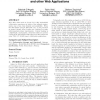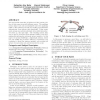1401 search results - page 226 / 281 » A Security Policy Model for Clinical Information Systems |
WWW
2011
ACM
13 years 3 months ago
2011
ACM
Online social media are complementing and in some cases replacing person-to-person social interaction and redefining the diffusion of information. In particular, microblogs have ...
WORM
2003
13 years 10 months ago
2003
This paper presents DOME, a host-based technique for detecting several general classes of malicious code in software executables. DOME uses static analysis to identify the locatio...
SAC
2010
ACM
14 years 3 months ago
2010
ACM
Web office suites such as Google Docs offer unparalleled collaboration experiences in terms of low software requirements, ease of use, data ubiquity, and availability. When the d...
SIGCOMM
2009
ACM
14 years 3 months ago
2009
ACM
For most mobile networks, providers need the current position of their users to provide efficient service. The resulting motion data is not only an invaluable source for analyzing...
ICECCS
2005
IEEE
14 years 2 months ago
2005
IEEE
The JavaScript language is used to enhance the clientside display of web pages. JavaScript code is downloaded into browsers and executed on-the-fly by an embedded interpreter. Br...


